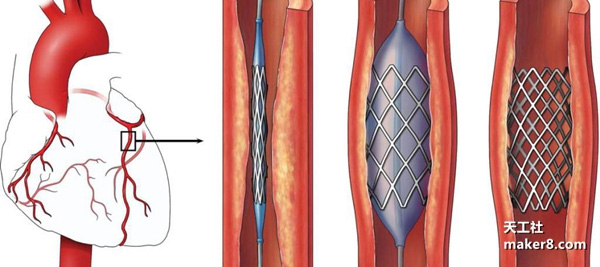Recently, researchers at the Technical University of Eindhoven (Tu / e) in the Netherlands published a proof of concept for 3D printed self-expanding, biodegradable stents in the online magazine "3D Printing and Additive Manufacturing". The stent is suitable for minimally invasive surgery and can support stenotic or weakly diseased cardiac arteries, especially in children.
Fighting heart disease
Heart disease can cause plaque build-up, which can make the arteries thicker or weaker. As shown above, the stent is used to open the diseased artery. In a typical stent installation, a balloon can be used to open the mesh material and push the accumulated plaque in the artery. Over time, the stent is absorbed by the cells and becomes part of the artery. The reason why the plaque is not removed directly is because it causes further damage to the artery.

In the study, the Tu/e team removed the balloon system and replaced it with a stent that can be deployed autonomously in the artery (see figure below). This stent is made of a polymer that can be absorbed by the body, rather than a typical nickel-titanium (Nitinol) metal to enhance body comfort and acceptance.

Testing plastic brackets
Using the design parameters of a typical Nitinol stent, the researchers created a computerized design of a plastic polymer scaffold. By simulating the extrusion test, the researcher continually modified the design of the plastic stent until its response was comparable to or better than that of the Nitinol stent.
The researchers then printed the experimental scaffold on a MakerBot Replicator 2X FDM 3D. The prototype used was FlexiFil, a TPC (thermoplastic copolyester) wire that was as flexible as rubber. FelixFil is manufactured by Formfutura.
Researchers have tested the prototype several times to evaluate its mechanical properties and biodegradability. They compared these results to the same tests on the Nitinol stent to ensure proper matching.
As shown in the figure above, the FlexiFil bracket can be mounted in the ideal 10mm diameter during the crimp test. After the water is added, the stent is automatically pushed out of a rigid tube and expanded into a complete shape.

Shanghai J.Shine Co.,Ltd , https://www.jshinechem.com